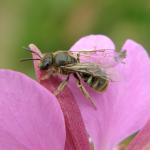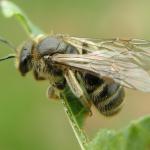A very similar species to the more common Lasioglossum lativentre (Schenck) and some records are probably due to misidentification of that species. Perkins (1922) unfortunately transposed the male genitalia characters, the most reliable way of distinguishing the two species, in his seminal paper on Lasioglossum.
Found from Dorset eastwards to Kent, and north to Yorkshire and Lancashire, and found in south Wales. It is also reported from the Channel Islands.
This is a Palaearctic species, found from Britain to Kazakhstan, north to Sweden and in the south (based on males) in Italy and Greece to north-east Turkey. Reports from the south, outside these areas, are based on females which may not be correctly determined (A W Ebmer, pers. comm.).
Listed as Nationally Notable/Na (now known as Nationally Scarce) in Falk (1991).
Found on heaths, calcareous grassland and in open woodland.
Univoltine. The female flies from late March to late September and the male, from late July to late September.
This is presumed to be a solitary mining bee, although the nesting biology is not known.
The bee visits a wide range of plants in Britain, including Asteraceae, Ranunculaceae, Euphorbiacaeae, Ericaceae and Scrophulariaceae (Falk, 1991; S Roberts, pers. comm.).
Sphecodes ephippius (Linnaeus) and Sphecodes puncticeps Thomson are believed to be cleptoparasites of this bee.
2016



